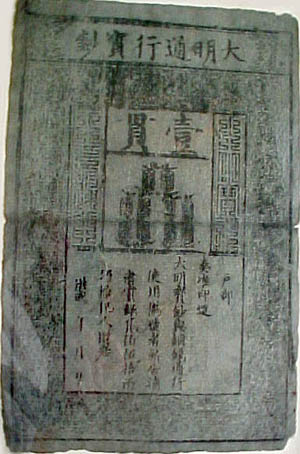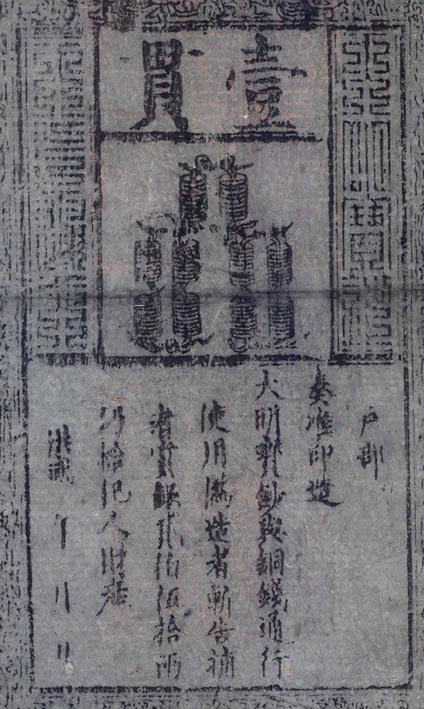The use of money in China could be traced back to at least four thousand years ago. China was also the first country to use paper money, or credit currency in the world. Ancient paper money can only be described in general terms for lack of material objects. About the Pai-Lu P'i-pi  (white deer-skin money) of Han Dynasty and the Fei-Chien (white deer-skin money) of Han Dynasty and the Fei-Chien  (flying money) of Tang Dynasty, I personally have never seen the actual objects. However, the official issuing of paper money in Sung Dynasty is famous in the field of numismatic. [Chiao-Tzu (flying money) of Tang Dynasty, I personally have never seen the actual objects. However, the official issuing of paper money in Sung Dynasty is famous in the field of numismatic. [Chiao-Tzu  (1008AD) and Chien-Yin (1008AD) and Chien-Yin  (1105AD) of Northern Sung and Hui-Tzu (1105AD) of Northern Sung and Hui-Tzu  (1160AD) and Kuan-Tzu (1160AD) and Kuan-Tzu  (1131AD) of Southern Sung]. The use of paper moneys went on through the Yuan and Ming as well as the end of the Qing Dynasty. Paper money played its important roles in different stages of the money history of China. (1131AD) of Southern Sung]. The use of paper moneys went on through the Yuan and Ming as well as the end of the Qing Dynasty. Paper money played its important roles in different stages of the money history of China.I post below is an email from Ms. T. P. of West Danville in the state of Vermont, in an area called the Northeast Kingdom. It's very beautiful this time of year. She is not a collector of money, but her grandparents came to the country in the early 1900's. The note was given to her Father over 50 years ago by a very old Chinese lady. I received this email on 2000 Aug 12. The email is self-explanatory Subject: very old Chinese money Date: Sat, 12 Aug 2000 17:40:16 -0400 From: "T. P." Dear Sir, I recently came in to possession of what appears to be a very old piece of Chinese paper money. I have done some research on my own at our local library and museum and I have been told that it looks real. I have also bought some books about the history of money and I have compared my piece with pictures in these books with a magnifying glass and it looks the same. It appears to be a 'Great Ming Circulating Treasure Certificate'. It was given to my Father over 50 years ago by a very old Chinese lady who told him that it was very old and very valuable and to keep it safe. Since then it has been in a picture frame, covered by a glass all these years. I would appreciate it, if you could help me find out if this is real. I thank you for your time and if you want to get in touch with me, my address and phone number is: Mrs. T. P. PO. Box xxx West Danville, Vt. 0xxxx 1-802-684-xxxx |
Extremely Rare A ~ Very Rare B ~ Rare C ~ Not So Many D ~ Common E
issued by Hu Pao of Ming Dynasty

